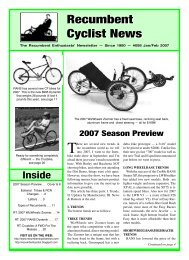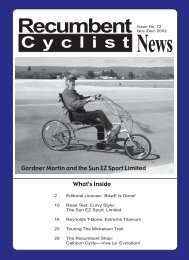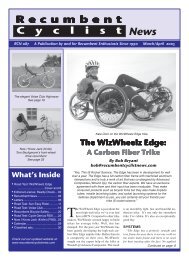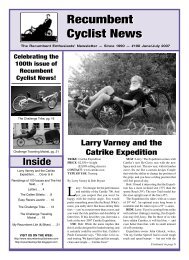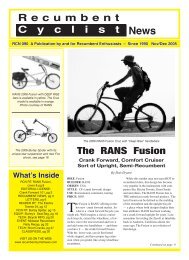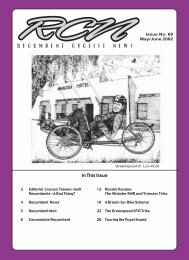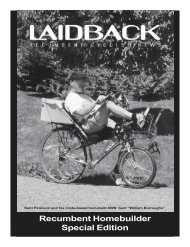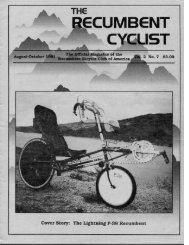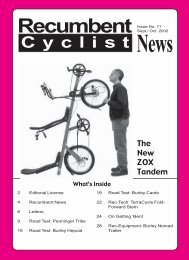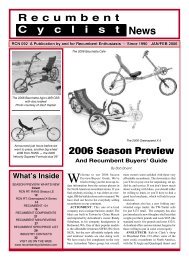C y c l i s t Recumbent - Steve Briggs
C y c l i s t Recumbent - Steve Briggs
C y c l i s t Recumbent - Steve Briggs
You also want an ePaper? Increase the reach of your titles
YUMPU automatically turns print PDFs into web optimized ePapers that Google loves.
Everything You (may or may not) Want To Know About<br />
<strong>Recumbent</strong> Bicycle Components<br />
By Bob Bryant<br />
Bicycle components have changed a lot<br />
over the years. We’re now in a world<br />
of disposable bicycle components,<br />
many of which are marketed like computer<br />
software and updates. That is the bad news.<br />
The good news is that fine bicycle components<br />
that will last for years, or even decades, are<br />
still available if you shop carefully. They might<br />
not come as part of the $800 bargain ‘bent you<br />
bought on the web, but they do exist.<br />
Just so you don’t think I’m a bike component<br />
snob, I’ll let you know a little secret: I<br />
like good cheap bikes. The last really good<br />
cheap bike I had was made by Schwinn in<br />
Chicago in 1972, and at the moment, I don’t<br />
own a single recumbent that sells for more than<br />
$2,000. All of my views are based on personal<br />
experience, research and discussions with<br />
friends in the business. But I also remember<br />
what my dad always told me: “There is no such<br />
thing as a free lunch.”<br />
You may never have a problem with the<br />
components on your $800 bargain ‘bent, but<br />
the following information is in case you do,<br />
or in case you ever want to upgrade your bike<br />
or if you build a custom spec recumbent. I’ve<br />
gone right down the list of components that<br />
come on most recumbent bicycles. Enjoy!<br />
Cranksets<br />
Choosing the right crankset and gearing will<br />
be one of the most important decisions in selecting<br />
or building a quality recumbent bicycle.<br />
The variables are the length of the crank arm,<br />
the size of the chain ring and the quality of the<br />
crankset.<br />
Crank arm length<br />
For years we’ve relied on traditional cycling<br />
wisdom, or we’ve simply settled for the equipment<br />
chosen by the manufacturer. There is a<br />
far wider choice of components these days.<br />
One of the emerging, yet somewhat experimental<br />
trends in recumbent bicycles is the short<br />
crank arm.<br />
Fans of short cranks say they are easier on<br />
your knees and legs, provide more force to the<br />
pedals, promote spinning, provide a decrease<br />
in frontal area, improve ergonomics and decrease<br />
weight. Some riders also mention a decrease<br />
in joint pain because the pedal circle is<br />
smaller and because lower gear ranges can be<br />
used. I haven’t tried short cranks myself, but I<br />
plan to order a set soon.<br />
In the upright bicycle world the general nonscientific<br />
crank sizing goes something like this:<br />
18 <strong>Recumbent</strong> Cyclist News<br />
shorter riders use 165 mm cranks, medium size<br />
riders use 170 mm cranks and taller riders use<br />
175 mm cranks. I have found that these “standards”<br />
are often variable, and I’ve been fitted<br />
with 170 mm, 175 mm and even 180 mm<br />
cranks. I’m 6’ tall, with a 44.5” x-seam and a<br />
33.25” measured cycling inseam, and I’ve been<br />
riding with 175s for years. I’ve finally realized<br />
that they are just too long.<br />
<strong>Recumbent</strong> manufacturers may be slow to<br />
change, but there are some forward thinking<br />
manufacturers and enthusiasts out there who<br />
are talking about this. Short crank advocate<br />
Mark Stonich writes, “155 mm cranks work<br />
better than 170s for a wide range of people.<br />
Most of my customers say they spin much faster<br />
with short cranks, without feeling like they are<br />
making an effort to do so.” Mark went on to<br />
say, “Shorter cranks can be of particular benefit<br />
on ’bents with small drive wheels. The<br />
higher pedaling cadences they encourage can<br />
often eliminate the need for oversized<br />
chainrings or multispeed hubs.”<br />
Ian, Mick and Paul Sims of Greenspeed are<br />
also short crank advocates. In a recent<br />
Greenspeed newsletter, Ian wrote, “Paul took<br />
the 175 mm cranks off his personal GTR, and<br />
fitted 100 mm cranks. He found such an immediate<br />
improvement in both performance and<br />
the stress on his knees and legs, that he announced<br />
that there was no way he was ever<br />
going back to using normal size cranks.” Ian<br />
noted further, “Paul did some testing on our<br />
Computrainer dynameter. He tried four different<br />
lengths — 175, 155, 125, and 100 mm. Over<br />
the four lengths, power output was virtually<br />
constant, with a slight reduction of maximum<br />
power for the 100 mm.”<br />
Mark Mueller of Windwrap Fairings has<br />
written, “I’m 5’11” and using 110 mm cranks<br />
on my Greenspeed SLR (my primary vehicle;<br />
140 mm cranks are standard on this model)<br />
and my Volae highracer. My brother, Carl, is<br />
5’ 10.5” and runs a 143 mm crank. He says<br />
his legs and especially his knees are less fatigued<br />
with the short cranks.”<br />
Where to get short crank arms: Mark Stonich<br />
converts 155mm Dotek BMX cranks to touring<br />
triples, with 74 mm or 58 mm inner bolt<br />
circles. Complete cranksets start from $95.95<br />
on up depending on your choice of chainrings.<br />
Modified arms only are $60 or he can shorten<br />
Shimano 105s for $35. (www.bikesmith<br />
design.com)<br />
Mark offers this gear selection advice: “If<br />
you are getting spun out with 170s, gear the<br />
same with 155s. Otherwise dropping 4 or 6<br />
teeth on each ring seems to work well. Most<br />
people are going from 30-42-52 to 26-36-46<br />
or 24-34-44. Faster riders are using 28-38-48.”<br />
Mark also offers bicycle related design and<br />
metalworking services. Such as design and<br />
prototyping of many of Calhoun Cycle’s “Evolution”<br />
products.<br />
Greenspeed does crank arm shortening. Visit<br />
www.greenspeed.com.au for info.<br />
HP Velotechnik offers relatively inexpensive<br />
Tracer 155 mm 30/42/52 cranks on their bikes.<br />
These use a square taper BB and have a black<br />
finish (Zach Kaplan).<br />
Peter White Cycles offers 155 mm TA<br />
Carmina triple cranks. This buffed alloy crank<br />
has a black interchangeable spider and auto<br />
extractor bolts. It comes in many sizes from<br />
155 mm - 185 mm. This crank can be fitted<br />
with 20-24 tooth inside rings, 30-40 middle<br />
rings and 42-50 outside rings and sells for $275<br />
(www.peterwhitecycles.com).<br />
While the Hostel Shoppe has yet to advocate<br />
this new trend, it does offer short cranks<br />
for shorter riders in 150 mm and 158 mm<br />
lengths, 30/42/52, for an ISIS BB for $125.<br />
(www.hostelshoppe.com).<br />
Chainring Sizes<br />
Many recumbents come with off-the-shelf<br />
“road triple” cranksets with relatively high<br />
gears (30/42/52). Many riders will want to<br />
widen their gearing to provide lower lows, and<br />
perhaps a lower middle chain ring as well.<br />
To find gears that you need, you need a point<br />
of reference. Once you are in your regular<br />
riding shape, climb some hills and determine<br />
the gear that works best for you by counting<br />
the number of teeth on the front chain ring and<br />
the rear cog. If you don’t have a low enough<br />
gear, you need a smaller inside chain ring or a<br />
cassette with a larger inside cog. The best way<br />
to accomplish this is to replace your cassette<br />
with a wide range 11-34 and add a 24-tooth<br />
inside chain ring to your crankset. (If you need<br />
more information, read my gearing rant in<br />
RCN 079.)<br />
If you are shifting into your granny low gear<br />
too early on a hill, consider a middle chain<br />
ring with fewer teeth to lower your mid-range<br />
gearing. This is a highly personal selection<br />
process that depends on your fitness level, your<br />
home terrain, the cargo/weight you carry and<br />
the hills or mountains you ride over.<br />
To find a chainring to fit your crankset, our<br />
advice is to contact your local recumbent spe-



